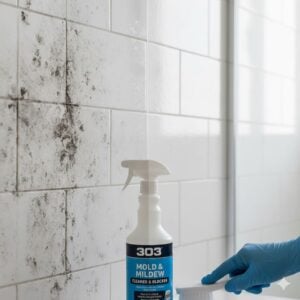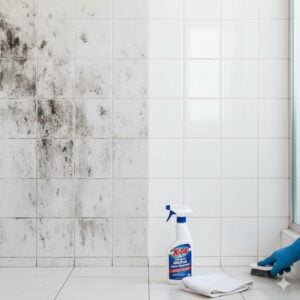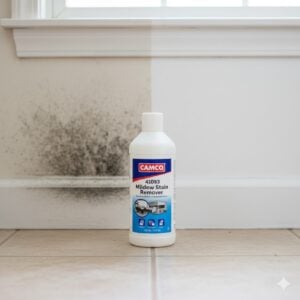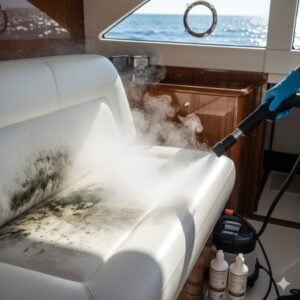Black mildew is one of the most unpleasant and stubborn problems homeowners face, especially in humid regions like the UAE. It thrives in dark, damp areas—bathrooms, kitchens, and air-conditioned spaces with poor ventilation. Many people attempt DIY cleaning methods to save time and money, but not all work safely or effectively. In some cases, improper cleaning can worsen the problem or spread spores across the home. This guide explains everything you need to know about mildew black: effective DIY tips, the hidden risks of do-it-yourself approaches, and how the cost compares to hiring professional cleaning experts like Bio-On UAE.
Table of Contents
ToggleWhat Is Black Mildew?
Black mildew is a type of fungus similar to mold but usually less toxic. It appears as dark gray or black patches on walls, tiles, ceilings, and even furniture. It grows in areas with poor ventilation and high humidity, feeding on organic materials like wood, paint, or even soap scum. Although not as dangerous as black mold (Stachybotrys chartarum), it can still trigger allergies, respiratory irritation, and unpleasant odors.
In the UAE, where temperature and moisture vary throughout the year, black mildew often forms due to condensation from air conditioners, water leaks, or lack of sunlight in certain rooms. Early identification and proper treatment are key to preventing serious damage.
How to Identify Black Mildew
To know whether you’re dealing with black mildew or dirt, check the following signs:
- Dark or greenish-black spots that spread in irregular patterns
- Musty odor even after cleaning the area
- Soft, damp texture on walls or ceilings
- Peeling paint or discoloration around air vents or corners
- Recurring patches despite wiping or repainting
If these symptoms appear, you likely have mildew growing beneath the surface rather than simple dirt buildup.
DIY Tips for Removing Black Mildew
If the infestation is small and limited to surface growth, you can attempt safe DIY cleaning using the following steps:
- 1. Ventilate the area: Open windows or turn on exhaust fans to prevent inhaling spores.
- 2. Wear protection: Use gloves and a mask to avoid direct contact with mildew spores.
- 3. Prepare a mild cleaning solution: Mix one cup of white vinegar or a tablespoon of baking soda in a spray bottle filled with water.
- 4. Apply to affected areas: Spray the solution and let it sit for 10–15 minutes to break down the mildew.
- 5. Scrub gently: Use a soft brush or cloth to remove the residue without damaging the wall paint or tiles.
- 6. Rinse and dry completely: Wipe clean and dry thoroughly with a towel or air dryer to prevent regrowth.
Vinegar and baking soda are natural antifungal agents, making them safe alternatives to harsh chemical bleaches. However, they only work effectively for surface-level mildew—not deep-rooted colonies or infestations behind walls.
DIY Cleaning Solutions to Avoid
Some popular online tips can cause more harm than good. Avoid using:
- Bleach on porous materials: Bleach kills surface mold but leaves behind spores in drywall, wood, or grout.
- Ammonia-based cleaners: These release toxic fumes when mixed with other chemicals.
- Over-scrubbing: Harsh scrubbing spreads spores and damages paint or surfaces.
- High-pressure washing indoors: This forces moisture deeper into walls, worsening mildew growth.
Risks of DIY Mildew Removal
While DIY may seem practical, it carries several hidden risks, especially if mildew has spread unseen behind tiles or walls:
- Incomplete removal: Home cleaning methods only eliminate surface mildew, not hidden colonies within walls or ceilings.
- Spore spread: Disturbing mildew without proper containment spreads spores throughout the air.
- Health impact: Inhaling spores during cleaning can cause allergies, coughing, or eye irritation.
- Material damage: Using the wrong cleaner can discolor walls, damage sealants, or corrode metal fittings.
- Short-term results: Mildew often returns within weeks after DIY cleaning because moisture sources remain untreated.
For extensive infestations, professional intervention is the safest and most effective option.
Professional Mildew Cleaning: How Experts Work
Companies like Bio-On UAE use advanced techniques designed not only to remove mildew but also to prevent it from returning. Their process includes:
- 1. Inspection: Identifying moisture sources, wall damage, and type of mildew present.
- 2. Containment: Sealing off affected areas to prevent spores from spreading.
- 3. Surface cleaning: Using medical-grade disinfectants and HEPA vacuums to capture spores.
- 4. Steam or ozone treatment: Killing mildew roots deep within porous surfaces.
- 5. Dehumidification: Removing excess moisture to prevent regrowth.
- 6. Preventive coating: Applying anti-microbial sealants that protect walls and tiles long term.
Professional services are especially critical in bathrooms, kitchens, and basements, where DIY methods often fail to control moisture.
DIY vs Professional Cleaning: Cost Comparison
The cost of cleaning black mildew varies based on area size and contamination depth. Below is a simple comparison between DIY and expert methods in the UAE:
| Type | Tools/Materials | Approx. Cost (AED) | Effectiveness |
|---|---|---|---|
| DIY Vinegar/Baking Soda | Spray bottle, vinegar, brush, gloves | 20–40 | Good for small surface stains only |
| DIY Bleach/Store Products | Bleach solution, scrubbing pads | 30–60 | Short-term fix, risk of damage |
| Professional Cleaning (Bio-On UAE) | Steam extraction, ozone treatment, sanitization | 20–40 per sq.m | Full mildew removal and prevention |
Note: Bio-On UAE offers free inspection for areas larger than 10 sq.m and provides transparent estimates before starting work.
Why Professional Cleaning Is Worth It
Professional mildew removal ensures safety, durability, and long-term cleanliness. Bio-On UAE uses non-toxic, European-approved products that are safe for pets, children, and sensitive individuals. They address not only visible mildew but also hidden moisture issues that cause reappearance.
DIY cleaning removes stains temporarily; professional cleaning eliminates the source. The difference shows in results that last for months rather than days. The treatment also improves indoor air quality and eliminates musty odors completely.
Preventing Black Mildew from Coming Back
- Keep rooms well-ventilated; use exhaust fans or open windows regularly.
- Fix leaks immediately — even small drips encourage mildew growth.
- Clean AC filters and ducts monthly to prevent humidity buildup.
- Use dehumidifiers in closed spaces or during rainy seasons.
- Book periodic professional cleaning to maintain hygienic conditions.
Maintaining low humidity (below 50%) is the best long-term prevention against mildew in UAE homes.
When to Call a Professional Immediately
DIY methods are only suitable for small, contained patches. Contact experts like Bio-On UAE if you notice:
- Widespread mildew across walls or ceilings
- Reappearance within days after cleaning
- Persistent musty smell despite ventilation
- Dark stains spreading behind paint or wallpaper
- Family members experiencing respiratory irritation
Conclusion
Black mildew is more than an eyesore—it’s a warning sign of hidden moisture and unhealthy indoor air. While DIY cleaning methods using vinegar or baking soda can control small spots, they don’t eliminate the problem completely. Professional mildew black cleaning services like Bio-On UAE provide a long-lasting solution through deep cleaning, disinfection, and prevention. The cost difference between DIY and expert cleaning is minor compared to the peace of mind, safety, and health benefits professionals offer. To protect your home and air quality, reach out to Bio-On UAE for an inspection and let your walls breathe clean again.













